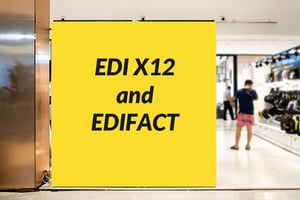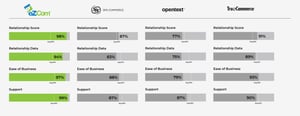Labels are more than just sticky notes with addresses on them. Their accuracy is key not only for ensuring shipments get to where they need to go but also towards building strong trading partner relationships.
Labels - specifically GS1-128 labels - can be tough to get excited about, but there are four things every supplier needs to know about them.
1. Understanding the GS1-128
The GS1-128 barcode provides identifying information, such as SKUs, descriptions, and pertinent dates for the contents of each carton that is shipped. The encoded product information can be used for shipping, receiving, and warehousing. This allows the shipment to easily be processed, getting the goods into the retail environment quickly.
The GS1-128 is the essential link to your item as it moves through the supply chain.
Our award-winning EDI platform, Lingo, can create a serialized number when a carton is packed. When the label is printed, Lingo turns that number into a bar code. When a trading partner receives the carton, they scan the barcode, which will match the information transmitted on the Advanced Shipping Notice (ASN) that corresponds to the shipment.
When creating GS1-128 labels, your GS1 Company Prefix is used in order to identify the contents of the carton as coming from your company. This is the same prefix that you use for the UPCs that are assigned to each of your products.
When using our Lingo platform to create your GS1-128 labels, you have the option to create hundreds of labels at one time using the Batch Processing feature.
Want to dive deeper into the GS1-128? Check out these GS1 FAQs.
2. GS1-128 Label Printing Options
When it comes to printing GS1-128 labels, you have a few options.
Print the labels yourself
Lingo allows you to print your labels on-demand, using a laser or thermal printer. The result is a high quality, durable image, whether you are printing a few labels or hundreds of them.
Create a PDF for warehouse production
With software like Lingo, you can create a PDF version of your labels and route them directly to your warehouse. They take it from there.
eZCom Services
We print GS1-128 labels for our customers at our headquarters. This can be done easily through the Lingo platform by selecting the ASNs you need labels printed for, and then placing the order in just a few clicks. We’ll then ship the GS1-128 labels to you via UPS, FedEx or USPS.
3. Understanding Different Types of Labels
There are a few different kinds of labels, each with their own benefits.
Paired Labels
With paired labels, GS1-128 and shipping labels are printed consecutively. That means you are not wasting your time matching the two labels when affixing them to your cartons. When you are printing hundreds or even thousands of labels, this is important.
Crack and Peel
Crack and Peel is a packing slip that also has a parcel label on the same print out, separated by a perforation. Simply place the packing slip inside the carton, and adhere the shipping label portion to the outside. Available for certain retailers, this solution will not only help you dramatically reduce errors, but save time as well.
4. GS1-128 Labels are Kind of Our Thing
We know how important labels are. We also know they can be burdensome. As an EDI provider powered by people, our U.S.-based support team is always happy to talk labels, shipping options… anything you like. Contact us any time.







